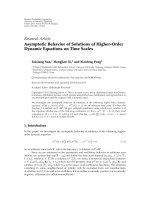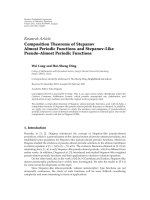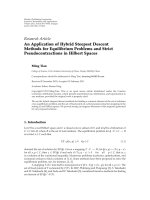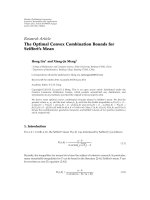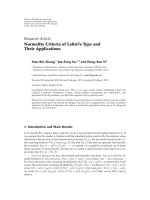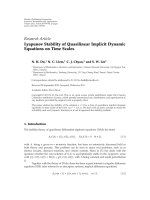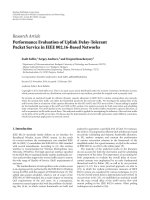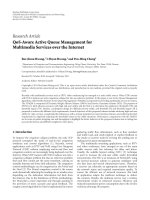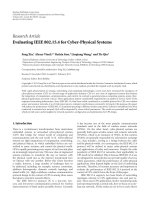Báo cáo hóa học: " Research Article Enumerative Encoding of TMTR Codes for Optical Recording Channel" pot
Bạn đang xem bản rút gọn của tài liệu. Xem và tải ngay bản đầy đủ của tài liệu tại đây (823.09 KB, 9 trang )
Hindawi Publishing Corporation
EURASIP Journal on Advances in Signal Processing
Volume 2010, Article ID 695237, 9 pages
doi:10.1155/2010/695237
Research Article
Enumerative Encoding of TMTR Codes for
Optical Recording Channel
Hui-Feng Tsai
Department of Computer Science and Information Engineering, Ching Yun University, Jhongli City 32097, Taiwan
Correspondence should be addressed to Hui-Feng Tsai,
Received 26 July 2010; Accepted 19 September 2010
Academic Editor: Magnus Jansson
Copyright © 2010 Hui-Feng Tsai. This is an open access article distributed under the Creative Commons Attribution License,
which permits unrestricted use, dist ribution, and reproduction in any medium, provided the original work is properly cited.
We propose a new time-varying maximum transition run (TMTR) code for DVD recording systems, which has a rate 8/11 higher
than the EFMPlus code and a lower power spectral density (PSD) at low frequencies. An enumeration method for constructing
the new TMTR code is presented. Computer simulations indicate that the proposed TMTR code outperforms the EFMPlus code
in error performance when applied to partial response optical recording channels.
1. Introduction
In data storage systems, a modulation code is know n as
(d, k)-constrained code, where d and k represent the maxi-
mal a nd minimal number of zeros between two consecutive
ones. The main function of a (d, k) modulation code is
to improve the recording density and increase the storage
capacity. The timing information could also be controlled
using a (d, k) modulation code. For example, magnetic tape
and disk systems often adopt (1, 7) or (2, 7) codes, while
optical systems such as CD and DVD usually employ (2, 10)
EFM (Eight-to-Fourteen Modulation) or (2, 10) EFMPlus
[1] modulation codes.
Recent research on the (d, k) modulation code has
focused on the time-var ying maximum transition run
(TMTR) code [2–9], which can be treated as a (0, k)
modulation code. The TMTR code matched to the partial
response channel can delete some dominant error events
and enhance the Euclidian distance of the partial response
channel to the matched filter bound. As a result, a coding
gain over the conventional scheme can be obtained when
the time-varying Viterbi detector is applied to the TMTR-
coded partial response channel. In a previous work [10],
we proposed a new time-varying maximum transition run
(TMTR) code with (k
even
1
= 1, k
odd
1
= 2, k) constraint
for DVD recording systems, which has rate 8/11 higher
than the EFMPlus code and a lower power spectral density
(PSD) at low frequencies. The (k
even
1
= 1, k
odd
1
= 2, k)
TMTR code was realized with a look-up table, and the k-
constraint was not considered during construction. In this
paper, instead of a look-up table we present an enumeration
method for constructing the (k
even
1
= 1, k
odd
1
= 2, k)codes.
Based on this construction, a rate 8/11 code with k
= 7is
found. The proposed code can achieve better t iming recovery
performance. We show that 387 surv iving words exist with
length 11 from the construction technique. This new method
needs one bit of memory for encoding, but no memory is
required for decoding. An enumerating algorithm is used for
encoding/decoding, and a look-up table is not required.
The rest of this paper is organized as follows. In Section 2,
we briefly describe the (k
even
1
= 1, k
odd
1
= 2, k)TMTR
codes for partial response (PR) optical recording channels.
In Section 3, an outline of the design methodology for
constructing a high-rate TMTR code is presented. We
illustrate concatenation problem between codewords and
provide a solution. Section 4 introduces an enumerative
coding method for TMTR codes. In Section 5, the power
spectral density (PSD) of the rate 8/11 code is evaluated and
compared with the EFMPlus code. An error performance
comparison between uncoded, TMTR-coded, and EFMPlus-
coded EPRII optical recording channel is presented in
Section 6. The conclusion is provided in Section 7.
2 EURASIP Journal on Advances in Signal Processing
0
0
1
1
Figure 1: FSTD of TMTR constraint.
1
S
2
S
3
S
1
00
0.1
Figure 2: Simplified FSTD with TMTR constraint.
2. TMTR Codes for Partial Response Optical
Recording Channels
The maximum transition run (MTR) method is a coding
method, which limits the number of consecutive potential
variations being not greater than k. The time-varying
maximum transition run (TMTR) is a further modification
of the MTR, which sets different constraints for the number
of consecutive variations depending upon whether it starts
at an odd or even p osition. For example, (k
even
1
, k
odd
1
)TMTR
constraints mean that the number of consecutive 1s starting
at an even position is not greater than k
even
1
and the number
of consecutive 1s starting at an odd position is not greater
than k
odd
1
. The method can increase the minimum distance of
the encoded system to an upper matched filter bound (MFB);
therefore, it has the distance enhancing property. The TMTR
constraint can be described using a finite state transition
diagram (FSTD), given in Figure 1. The vertices at the top
of the diagram represent even positions, and the number
of 1s starting at the even positions can be 1 only, satisfying
the constraint of k
even
1
= 1. The vertex at the bottom of
the diagram represents odd positions, and the number of
1s starting at the odd positions can be 1 or 2, satisfying the
constraint of k
odd
1
= 2. Figure 2 shows a simplified FSTD with
the (k
even
1
= 1, k
odd
1
= 2) TMTR constraints.
Cideciyan et al. [11] suggested an advanced signal pro-
cessing technique, the partial response and maximal likeli-
hood (PRML) channel, to further increase the recording den-
sities and reliability over that achieved by the conventional
peak detector. The signal processing technique employing the
PRML channel has become a standard widely used in most
of today’s data storage systems. The most popular partial
response system for optical recording has the form (1 + D)
n
,
where n is a nonnegative integer. The PR systems with n
=
2 and 3 are referred to as the PRII and EPRII systems,
respectively. Karabed and Siegel [12] proposed a class of
modulation codes that take advantage of the well-defined
spectral nulls presented in partial response channels. The
time-varying maximum transition run (TMTR) code [2–9],
whichcanbetreatedasa(0,k) modulation code, has recently
been studied for partial response channels. The TMTR code
matched to the partial response channel can delete some
dominant error events and enhance the Euclidian distance
of the partial response channel.
Vannucci and Foschini [13] described a powerful algo-
rithm to search for the minimum Euclidean distance d
2
min
for (1 + D)
n
partial response channels. They found that the
shortest error event achieving d
2
min
has the type of “ 0+
−0 ” for most of (1 + D)
n
partial response channels. As
a matter of fact they found that those error events of the
form “ 0+
−(+−)0 ” always have a distance less than the
matched filter bound d
2
MFB
which is defined as the distance
corresponding to the one-bit error event.
If the error event “ 0+
−0 ” can be forbidden to
occur in coded sequences for (1 + D)
n
partial response chan-
nels, the minimum distance of the channels can be increased
to d
2
MFB
resulting in a coding gain of 10 log(d
2
MFB
/d
2
min
)dB.
With NRZI modulation there are four pairs of binary coded
sequences, which could generate the error event “ 0+
−0 , ” shown as follows:
110 111 010 011
011 010 111 110
(1)
The TMTR modulation code w ith constraint (0, k
even
1
=
1, k
odd
1
= 2) can be used to forbid the occurrence of sequences
111 and 011,andasaresulterrorevent“ 0+
−0 ”
would not occur in the detection of (1 + D)
3
channels, and
a coding gain of 3 dB can be obtained. The channel capacity
of the (0, k
even
1
= 1, k
odd
1
= 2) TMTR code is equal to 0.7929,
which indicates that a codeword with length 11 bits at least is
required to encode or represent a byte (8-bit) message.
3. Construction for (k
even
1
= 1, k
odd
1
= 2, k)
TMTR Codes
A TMTR code is specified as (k
even
1
= 1, k
odd
1
= 2, k)
constraint, where k is the maximum number of consecutive
zeros, k
even
1
and k
odd
1
constraints represent the maximum
numbers of consecutive ones starting from an even position
and an odd position, respectively. This construction is based
upon (k
even
1
= 1, k
odd
1
= 2, k; r
1
, r
0
, l
1
, l
0
) constraint. Both
r
1
and r
0
represent the maximum number of ones a fter the
last zero and the maximum number of zeros after the last
one, respectively. In similar, parameters l
1
and l
0
represent
the maximum number of ones before the first zero and the
maximum number of zeros before the first one. Any two
sequences satisfying (k
even
1
= 1, k
odd
1
= 2, k; r
1
, r
0
, l
1
, l
0
) =
(1, 2, k;1,k − 1, 1, k) constraint can be freely concatenated
without violating the (k
even
1
= 1, k
odd
1
= 2, k) constraint.
In order to reduce the consecutive zero length in the
sequences after concatenation, the following substitution
rule is applied: assume that a sequence y is followed by
EURASIP Journal on Advances in Signal Processing 3
asequencex, then
(1) if x has more than 2 zeros before the first one, and the
last bit of y is a zero, then flip the first 2 bits of x into
two ones, for example, (000 101) → (110 101);
(2) other wise, use x as the encoder output.
In the case of (1), a long sequence of consecutive zeros
is spread into two parts by “11” in the beginning of the 2nd
sequence. Because l
1
= 1, a sequence beginning w ith “11” is
not an original code.
Rates of some constructed codes using this method are
listed in Table 1. As displayed, a rate 8/11 code with k
even
1
= 1
and k
odd
1
= 2 constra ints is found, and this code has the k = 7
constraint. Sequences of even lengths satisfying the (k
even
1
=
1, k
odd
1
= 2, k) constraint can be freely concatenated without
violating the (k
even
1
= 1, k
odd
1
= 2) constraint. Odd lengths
sequences, however, cannot be freely concatenated without
violating the (k
even
1
= 2, k
odd
1
= 1) constraint. To solve
this problem, assuming that there is a modulo-11 counter
synchronized to the data, the two transitions in arrow can
end at times 1, 2, 4, 6, 8, and 10 relative to counter. The
even and odd positions in a codeword of 11 bits are given as
(eoeoeoeoeoe). For example, a sequence of 3 codewords
will be
10987654321
,
10987654321
,
10987654321
eoeoeoeoeoe
,
eoeoeoeoeoe
,
eoeoeoeoeoe
12121212121
,
12121212121
,
12121212121
xeoeoeoeoeo
,
xeoeoeoeoeo
,
xeoeoeoeoeo
(2)
where the 1st line expresses the positions of the code bits.
The 2nd line expresses the even/odd code bit positions. The
3rd line expresses the maximum number of consecutive “1”
starting at the position. There is no two consecutive “2” in
the 3rd line. It means that no dominant error event
±(1, −1)
will occur. To obtain the coding gain of this encoder, a time-
varying Viterbi detector is required. The trellis diagrams
of the Viterbi detector for even and odd times are shown
in Figure 7(c). The Viterbi detector for code bit stream
positions w ill be the same as shifting the 2nd line to right
by 1 position. The result is shown in the 4th line. The even or
odd Viterbi detector properties must match the bit position
shown in the 4th line.
4. Enumerative Encoding (k
even
1
= 1, k
odd
1
= 2, k)
TMTR Codes
Let us lexicographically order the binary sequences of length
n by
X
=
(
x
n−1
, , x
1
, x
0
)
Y =
y
n−1
, , y
1
, y
0
⇐⇒
x
p
>y
p
and
x
i
= y
i
∀
p<i<n.
(3)
An enumerating encoder maps a set of consecutive integers
onto a lexicographically ordered set of sequences. In order to
describe the enumerating encoder/decoder, some notations
will be defined as follows.
(D.1) A
n
is the lexicographically ordered set of (k
even
1
=
1, k
odd
1
= 2, k; r
1
, r
0
, l
1
, l
0
) = (1, 2, k;1,k − 1, 1, ∞)
sequences of length n.
(D.2) R(X
) is the number of sequences Y ∈ A
n
such that
X
Y .
(D.3) R(0
) = 0, where 0 is the all zero sequence.
(D.4) res(X
) is the sequence obtained by modifying the first
nonzero bit of X
to zero.
(D.5) U
i
is the minimum sequence among sequences in A
n
and having the first symbol one at position i.
(D.6) M
i
is the maximum sequence among sequences in A
n
and having the first symbol one at position i.
(D.7) w
i
= R(U
i
)−R(res(U
i
)), then we have
R
(
X
)
=
n−1
i=0
x
i
w
i
. (4)
(D.8) We have t
i
= R(M
i
).
By definitions (D.5) and (D.6), it is easy to see that
R
U
i
=
t
i−1
+1. (5)
The w
i
’s and t
i
’s can be obtained by the following recursive
relation with initial values w
0
= 1, t
0
= 1:
w
i
= t
i−1
+1− R
res
U
i
,
t
i
= R
M
i
.
(6)
For illustration, consider (k
even
1
= 1, k
odd
1
= 2, k; r
1
,
r
0
, l
1
, l
0
) = (1,2,4;1,3,1,∞) sequences with length 4; one has
i 3210,
w
i
−→ 6321,
t
i
−→ 8521,
R
res
U
i
−→
0000,
(7)
4 EURASIP Journal on Advances in Signal Processing
Table 1: Practical code rates of (k
even
1
= 1, k
odd
1
= 2, k)codes.
Block length Code rate (k
even
1
= 1, k
odd
1
= 2, k)
44/5 (1, 2, 4)
53/5 (1, 2, 4)
64/6 (1, 2, 5)
75/7 (1, 2, 6)
86/8 (1, 2, 6)
97/9 (1, 2, 7)
10 7/10 (1,2,6)
11 8/11 (1,2,7)
12 9/12 (1,2,7)
20 14/20 (1,2,6)
22 16/22 (1,2,7)
24 18/24 (1,2,7)
where
M
0
=
(
0001
)
, U
0
=
(
0001
)
,
M
1
=
(
0010
)
, U
1
=
(
0010
)
,
M
2
=
(
0110
)
, U
2
=
(
0100
)
,
M
3
=
(
1010
)
, U
3
=
(
1000
)
.
(8)
Similarly, when using a codeword of length 11 and code
rate of 8/11, the enumerating encoding method is as follows:
i 10 9 8 76543210,
w
i
−→ 234 157 79 53 27 18 9 6 3 2 1,
t
i
−→ 470 236 158 79 53 26 17 8 5 2 1,
R
res
U
i
−→
6 3 2 11000000,
(9)
where
M
0
=
(
00000001010
)
, U
0
=
(
00000001000
)
,
M
1
=
(
00000011010
)
, U
1
=
(
00000010000
)
,
M
2
=
(
00000101010
)
, U
2
=
(
00000100000
)
,
M
3
=
(
00001101010
)
, U
3
=
(
00001000000
)
,
M
4
=
(
00010101010
)
, U
4
=
(
00010000001
)
,
M
5
=
(
00110101010
)
, U
5
=
(
00100000001
)
,
M
6
=
(
01010101010
)
, U
6
=
(
01000000010
)
,
M
7
=
(
10110101010
)
, U
7
=
(
10000000100
)
.
(10)
Let B
n
be a subset of A
n
consisting of sequences with no
more than k
= 7 leading zeros. Then the number of elements
of B
11
is given a s
|B
11
|=R
(
[
10110101010
]
)
− R
(
[
00000000110
]
)
= w
10
+ w
8
+ w
7
+ w
5
+ w
3
+ w
1
− w
2
− w
1
= 387.
(11)
β = β + t
n−k−1
+1
i
= n − 1
x
i
= 1
β
= β − w
i
x
n−1
= 1
x
n−2
= 1
x
0
= β
end
end
end
end
end
while i>0
if β>t
(i−1)
if (x
0
= 0)
if (x
n−1
= 0)
if (x
n−2
= 0)
Figure 3: Enumerative encoding for (k
even
1
, k
odd
1
, k)codes.
Table 2: Codebook of rate 3/4(k
even
1
= 1, k
odd
1
= 2, k = 4) code.
Data Codeword Data Codeword
b
1
···b
3
c
1
···c
4
b
1
···b
3
c
1
···c
4
000 0001or 1101 100 0110
001 0010 101 1000
010 0100 110 1001
011 0101 111 1010
We can then encode an integer β to a sequence X using
the enumerative algorithm given in Figure 3 (assuming the
previous block is X
). The decoding is simply done by
β =
n−1
i=0
x
i
w
i
− t
n−k−1
− 1, (12)
where t
n−k−1
+ 1 is the value of first codeword, t
i
= 0and
t
i
=−1fori<0.
For illustration, the mapping relationship between data
and codewords of a rate 3/4 code satisfying (k
even
1
= 1, k
odd
1
=
2, k = 4) constraint is given in Table 2. The data to codeword
mapping for a rate 8/11 code satisfying (k
even
1
= 1, k
odd
1
=
2, k = 7) constraint is listed in Ta ble 3.
5. Power Spectral Density
In DVD systems the power spectr al density at low frequency,
referred to as the low-frequency content, of the encoded data
sequences should normally be maintained as low as possible
to alleviate interference with pilot and focus servo signals.
For example, in addition to satisfying the (2, 10) constraint,
the 8/16 EFMPlus code employed in the DVD system is also
designed to achieve very low low-frequency content to reduce
the interference between the written signal a nd the servo
signal. Efficient low-frequency component suppression is a
crucial criterion for the 8/11 (0, k
even
1
= 1, k
odd
1
= 2, k = 7)
TMTR code rate. The low-frequency content is based upon
the running digital sum (RDS) Z given by
Z
i
=
i
j=−∞
X
j
= Z
i−1
+ X
i
, (13)
EURASIP Journal on Advances in Signal Processing 5
Table 3: Data to codeword mapping for the rate 8/11 (k
even
1
= 1, k
odd
1
= 2, k = 7) code.
Data Codeword Data Codeword Data Codeword Data Codeword
b
1
···b
8
c
1
c
2
···c
11
b
1
···b
8
c
1
c
2
···c
11
b
1
···b
8
c
1
c
2
···c
11
b
1
···b
8
c
1
c
2
···c
11
0 00000000 00000001000 42 00101010 00001100100 94 01011110 00100100100 178 10110010 01001000000
or 11000001000 or 11001100100 95 01011111 00100100101 179 10110011 01001000001
1 00000001 00000001001 43 00101011 00001100101 96 01100000 00100100110 180 10110100 01001000010
or 11000001001 or 11001100101 97 01100001 00100101000 181 10110101 01001000100
2 00000010 000000010 44 00101100 00001100110 98 01100010 00100101001 182 10110110 01001000101
or 11000001010 or 11001100110 99 01100011 00100101010 183 10110111 01001000110
3 00000011 00000010000 45 00101101 00001101000 100 01100100 00101000000 184 10111000 01001001000
or 11000010000 or 11001101000 101 01100101 00101000001 185 10111001 01001001001
4 00000100 00000010001 46 00101110 00001101001 102 01100110 00101000010 186 10111010 01001001010
or 11000010001 or 11001101001 103 01100111 00101000100 187 10111011 01001010000
5 00000101 00000010010 47 00101111 00001101010 104 01101000 00101000101 188 10111100 01001010001
or 11000010010 or 11001101010 105 01101001 00101000110 189 10111101 01001010010
6 00000110 00000010100 48 00110000 00010000001 106 01101010 00101001000 190 10111110 01001010100
or 11000010100 or 11010000001 107 01101011 00101001001 191 10111111 01001010101
7 00000111 00000010101 49 00110001 00010000010 108 01101100 00101001010 192 11000000 01001010110
or 11000010101 or 11010000010 109 01101101 00101010000 193 11000001 01001011000
8 00001000 00000010110 50 00110010 00010000100 110 01101110 00101010001 194 11000010 01001011001
or 11000010110 or 11010000100 111 01101111 00101010010 195 11000011 01001011010
9 00001001 00000011000 51 00110011 00010000101 112 01110000 00101010100 196 11000100 01001100000
or 11000011000 or 11010000101 113 01110001 00101010101 197 11000101 01001100001
10 00001010 00000011001 52 00110100 00010000110 114 01110010 00101010110 198 11000110 01001100010
or 11000011001 or 11010000110 115 01110011 00101011000 199 11000111 01001100100
11 00001011 00000011010 53 00110101 00010001000 116 01110100 00101011001 200 11001000 01001100101
or 11000011010 or 11010001000 117 01110101 00101011010 201 11001001 01001100110
12 00001100 00000100000 54 00110110 00010001001 118 01110110 00101100000 202 11001010 01001101000
or 11000100000 or 11010001001 119 01110111 00101100001 203 11001011 01001101001
13 00001101 00000100001 55 00110111 00010001010 120 01111000 00101100010 204 11001100 01001101010
or 11000100001 or 11010001010 121 01111001 00101100100 205 11001101 01010000001
14 00001110 00000100010 56 00111000 00010010000 122 01111010 00101100101 206 11001110 01010000010
or 11000100010 or 11010010000 123 01111011 00101100110 207 11001111 01010000100
15 00001111 00000100100 57 00111001 00010010001 124 01111100 00101101000 208 11010000 01010000101
or 11000100100 or 11010010001 125 01111101 00101101001 209 11010001 01010000110
16 00010000 00000100101 58 00111010 00010010010 126 01111110 00101101010 210 11010010 01010001000
or 11000100101 or 11010010010 127 01111111 00110000001 211 11010011 01010001001
17 00010001 00000100110 59 00111011 00010010100 128 10000000 00110000010 212 11010100 01010001010
or 11000100110 or 11010010100 129 10000001 00110000100 213 11010101 01010010000
18 00010010 00000101000 60 00111100 00010010101 130 10000010 00110000101 214 11010110 01010010001
or 11000101000 or 11010010101 131 10000011 00110000110 215 11010111 01010010010
19 00010011 00000101001 61 00111101 00010010110 132 10000100 00110001000 216 11011000 01010010100
or 11000101001 or 11010010110 133 10000101 00110001001 217 11011001 01010010101
20 00010100 00000101010 62 00111110 00010011000 134 10000110 00110001010 218 11011010 01010010110
or 11000101010 or 11010011000 135 10000111 00110010000 219 11011011 01010011000
21 00010101 00001000000 63 00111111 00010011001 136 10001000 00110010001 220 11011100 01010011001
or 11001000000 or 11010011001 137 10001001 00110010010 221 11011101 01010011010
22 00010110 00001000001 64 01000000 00010011010 138 10001010 00110010100 222 11011110 01010100000
or 1100100000 or 11010011010 139 10001011 00110010101 223 11011111 01010100001
23 00010111 00001000010 65 01000001 00010100000 140 10001100 00110010110 224 11100000 01010100010
or 11001000010 or 11010100000 141 10001101 00110011000 225 11100001 01010100100
24 00011000 00001000100 66 01000010 00010100001 142 10001110 00110011001 226 11100010 01010100101
or 11001000100 or 11010100001 143 10001111 00110011010 227 11100011 01010100110
25 00011001 00001000101 67 01000011 00010100010 144 10010000 00110100000 228 11100100 01010101000
or 11001000101 or 11010100010 145 10010001 00110100001 229 11100101 01010101001
6 EURASIP Journal on Advances in Signal Processing
Table 3: Continued.
Data Codeword Data Codeword Data Codeword Data Codeword
b
1
···b
8
c
1
c
2
···c
11
b
1
···b
8
c
1
c
2
···c
11
b
1
···b
8
c
1
c
2
···c
11
b
1
···b
8
c
1
c
2
···c
11
26 00011010 00001000110 68 01000100 00010100100 146 10010010 00110100010 230 11100110 01010101010
or 11001000110 or 11010100100 147 10010011 00110100100 231 11100111 10000000100
27 00011011 00001001000 69 01000101 00010100101 148 10010100 00110100101 232 11101000 10000000101
or 11001001000 or 11010100101 149 10010101 00110100110 233 11101001 10000000110
28 00011100 00001001001 70 01000110 00010100110 150 10010110 00110101000 234 11101010 10000001000
or 11001001001 or 11010100110 151 10010111 00110101001 235 11101011 10000001001
29 00011101 00001001010 71 01000111 00010101000 152 10011000 00110101010 236 11101100 10000001010
or 11001001010 or 11010101000 153 10011001 01000000010 237 11101101 10000010000
30 00011110 00001010000 72 01001000 00010101001 154 10011010 01000000100 238 11101110 10000010001
or 11001010000 or 11010101001 155 10011011 01000000101 239 11101111 10000010010
31 00011111 00001010001 73 01001001 00010101010 156 10011100 01000000110 240 11110000 10000010100
or 11001010001 or 11010101010 157 10011101 01000001000 241 11110001 10000010101
32 00100000 00001010010 74 01001010 00100000001 158 10011110 01000001001 242 11110010 10000010110
or 11001010010 75 01001011 00100000010 159 10011111 01000001010 243 11110011 10000011000
33 00100001 00001010100 76 01001100 00100000100 160 10100000 01000010000 244 11110100 10000011001
or 11001010100 77 01001101 00100000101 161 10100001 01000010001 245 11110101 10000011010
34 00100010 00001010101 78 01001110 00100000110 162 10100010 01000010010 246 11110110 10000100000
or 11001010101 79 01001111 00100001000 163 10100011 01000010100 247 11110111 10000100001
35 00100011 00001010110 80 01010000 00100001001 164 10100100 01000010101 248 11111000 10000100010
or 11001010110 81 01010001 00100001010 165 10100101 01000010110 249 11111001 10000100100
36 00100100 00001011000 82 01010010 00100010000 166 10100110 01000011000 250 11111010 10000100101
or 11001011000 83 01010011 00100010001 167 10100111 01000011001 251 11111011 10000100110
37 00100101 00001011001 84 01010100 00100010010 168 10101000 01000011010 252 11111100 10000101000
or 11001011001 85 01010101 00100010100 169 10101001 01000100000 253 11111101 10000101001
38 00100110 00001011010 86 01010110 00100010101 170 10101010 01000100001 254 11111110 10000101010
or 11001011010 87 01010111 00100010110 171 10101011 01000100010 255 11111111 10001000000
39 00100111 00001100000 88 01011000 00100011000 172 10101100 01000100100
or 11001100000 89 01011001 00100011001 173 10101101 01000100101
40 00101000 00001100001 90 01011010 00100011010 174 10101110 01000100110
or 11001100001 91 01011011 00100100000 175 10101111 01000101000
41 00101001 00001100010 92 01011100 00100100001 176 10110000 01000101001
or 11001100010 93 01011101 00100100010 177 10110001 01000101010
where {X
i
}={ , X
−1
, X
0
, X
1
, }∈{−1, +1} represents
the w riting sequences. A lower RDS results in lower low-
frequency content. The power sp ectral density of a sequence
can be expressed as
H
(
w
)
= lim
M →∞
E
⎡
⎢
⎣
1
2M +1
M
m=−M
X
m
e
−jmw
2
⎤
⎥
⎦
. (14)
For a bounded RDS, that is,
|Z
i
|=|
i
j
=−∞
X
j
|≤C<∞,
C is a constant, and the DC content is then given as
H
(
0
)
= lim
M →∞
E
⎡
⎢
⎣
1
2M +1
M
m=−M
X
m
2
⎤
⎥
⎦
≈
0, (15)
that indicates a DC-free content. As shown in (11), the
number of sequences with length 11 satisfying (k
even
1
=
1, k
odd
1
= 2, k, r
1
, r
0
, l
1
, l
0
) = (1,2,7;1,6,1,∞) is 387, but
it only requires 256 codewords in the rate 8/11 TMTR
code. The surplus 387
− 256 = 131 code sequences can
be exploited for minimizing both k-constraint and low-
frequency content. The 131 surplus code sequences are then
used to suppress the low-frequency content by reducing the
running digital sum (RDS). There are two tables (a main
table and a substitute table) used in the encoder, as shown
in Figure 4. The main table consists of 256 codewords (i.e.,
sequences X
corresponding to 132 ≤ β ≤ 387 in the
enumerating algorithm), and the substitute table with 131
codewords (i.e., sequences X
corresponding to 1 ≤ β ≤
131) is used to minimize the power spectral density at low
frequencies.
EURASIP Journal on Advances in Signal Processing 7
0011000011 1
1
132
387 1011010101
1000100100
Main
table
0000000100
0011000010
Substitute
table
262 131
ββ
Sequence Sequence
00
0
0
.
.
.
.
.
.
.
.
.
.
.
.
.
.
.
.
.
.
X X
Figure 4: Codebook of r ate 8/11 (k
even
1
= 1, k
odd
1
= 2, 7) TMTR
code.
10
−4
10
−3
10
−2
10
−1
−50
−45
−40
−35
−30
−25
−20
−15
−10
−5
0
5
10
Frequency
PSD (dB)
EFMPlus code
8/11 TMTR code
3/4 TMTR code
Figure 5: Power spectral density.
ThePSDofbothEFMPluscodeand(0,k
even
1
= 1, k
odd
1
=
2) TMTR code can be computed using the fast Fourier
transform (FFT)
H
(
kw
s
)
∼
=
∞
n=1
X
n
W
(k−1)(n−1)
N
,
(16)
where W
k
N
= e
−j(2kπ/N)
, w
s
= 2π/N.
Figure 5 depicts the power spectral density (PSD) versus
the normalized frequency for the 8/16 EFMPlus code, the
rate 3/4(0,k
even
1
= 1, k
odd
1
= 2, k = 4) TMTR code, and the
8/11 (0, k
even
1
= 1, k
odd
1
= 2, k = 7) TMTR code with method
of enumerative, respectively. As shown, at frequency of 10
−4
,
the PSDs for both EFMPlus and TMTR codes are
−40 dB,
−4dB and−45 dB, respectively. The result indicates that the
8/11 (0, k
even
1
= 1, k
odd
1
= 2, k = 7) TMTR code achieves
{u
k
}
{
u
k
}
decoder
Optical recording
channel
AWG N
EPRII
equalizer
User data
decoder
User data
Viterbi
detector
encoder
8/11 TMTR
8/11 TMTR
Figure 6: Optical recording system model.
a lower low-frequency content (with 5 dB lower) than the
EFMPlus code. In Figure 5, we notice that the rate 3/4
(0, k
even
1
= 1, k
odd
1
= 2, k = 4) TMTR code has only −4dBat
frequency of 10
−4
and it is not suitable for optical recording
systems, although it has a higher code rate compared to the
8/11 (0, k
even
1
= 1, k
odd
1
= 2, k = 7) TMTR code.
6. Simulation Results
The superiority of the rate 8/11 (0, k
even
1
= 1, k
odd
1
= 2)
TMTR code over the EFMPlus code is also demonstrated
on error performance through a computer simulation on
the EPRII optical channel of the form P(D)
= (1 + D)
3
.
Figure 6 depicts the optical recording system for simulation.
An 8-state transition diagram, as depicted in Figure 7(a),
can describe the EPRII optical channel. During simulation,
a Gaussian optical recording channel was assumed with
impulse response m(t)givenby
m
(
t
)
=
2
√
πST
exp
−
2t
ST
2
, (17)
where S represents the user information density. T is the
channel bit period assumed to be one (T = 1) for uncoded
systems in simulation. The optical recording channel is then
corrupted with the additive white Gaussian noise (AWGN),
and at receiver an ideal EPRII equalizer is employed to
equalize the optical channel in the form of P(D)
= (1 + D)
3
.
The Viterbi detector is then employed on the 8-state trel-
lis diagram of the EPRII optical channel, to recover binary-
recorded data from the equalized and sampled output. Note
that for the EFMPlus-coded EPRII channel the 8-state trellis
diagram can be reduced to a 6-state trellis diagram due to
the (2, 10) constraint, as shown in Figure 7(b), while for
the TMTR-coded EPRII channel the 8-state trellis diagram
is stil l required with some branches deleted as depicted in
Figure 7(c). Figure 8 demonstrates the bit error rate versus
the signal to noise ratio (SNR) for TMTR-coded, EFMPlus-
coded and uncoded EPRII optical recording channels at user
density S
= 1.2. The SNR in dB is defined in this paper
as the ratio of the input complex waveform signal energy
generated by a 127-bit pseudorandom binary sequence to
the channel noise energy of the same duration. As shown
both the TMTR-coded and EFMPlus-coded EPRII systems
achieve better performance than the uncoded EPRII system.
8 EURASIP Journal on Advances in Signal Processing
000
100
010
110
001
101
011
111
000
100
010
110
001
101
011
111
0/0
1/1
0/3
1/4
0/3
1/4
0/4
1/5
0/4
1/5
0/7
1/8
0/0
1/1
0/3
1/4
0/3
1/4
0/4
1/5
0/4
1/5
0/7
1/8
0/1
1/2
0/6
1/7
0/1
1/2
0/6
1/7
(a)
0/0
1/1
1/4
0/1
0/0
1/1
1/4
0/1
1/7 1/7
0/4
0/4
0/7
0/7
1/8 1/8
000
100
110
001
011
111
000
100
110
001
011
111
(b)
0/1
1/2
0/6
1/7
1/2
0/6
1/7
0/0
1/1
0/3
1/4
0/3
1/5
0/4
1/5
0/7
1/8
0/0
1/1
1/4
0/3
0/1
1/5
0/4
0/7
1/8
Odd Even
000
100
010
110
001
101
011
111
000
100
010
110
001
101
011
111
(c)
Figure 7: Trellis diagram. (a) EPRII channel. (b) EFMPlus-coded EPRII channel. (c) TMTR-coded EPRII channel.
This is because both coded EPRII systems have a coding
gain of 3 dB when these modulation codes are considered
in the 8-state trellis diagram of the EPRII system during
detection. This leads to a coding gain of 3 dB. As also can be
seen in this figure, the TMTR-coded EPRII system improves
the EFMPlus-coded EPRII system by approximately 1 dB in
bit error rate. The coding loss of the EFMPlus-coded EPRII
system is due to the bit rate loss. Figure 9 shows the signal to
noise (SNR) required to achieve a bit rate error of 10
−5
,asa
function of user density, at a rate of 8/11 (0, k
even
1
= 1, k
odd
1
=
2) TMTR code and a rate of 8/16 EFMPlus code, applied
to an EPRII optical channel. Figure 9 shows how the TMTR
code provides little coding gain at user densities below 1.2 but
increases coding gain at higher densities. At a user density
of S
= 2.0, the TMTR code on the EPRII optical channel
provides nearly 2.7 dB of coding gain above the rate of 8/16
EFMPlus code on the EPRII optical channel. Therefore, from
the performance comparison made in Figure 9,itcanbe
seen that even a greater improvement in coding gain could
be achieved for TMTR-coded EPRII system at higher user
densities.
7. Conclusion
In this paper, we present an enumeration method for
constructing (k
even
1
= 1, k
odd
1
= 2, k) codes, and the look-
up table described in a previous work is not required
for the encoder/decoder. Based on the construction, a rate
EURASIP Journal on Advances in Signal Processing 9
4567891011
10
−6
10
−5
10
−4
10
−3
10
−2
10
−1
SNR (dB)
BER
Uncoded
EFMPlus code
TMTR code for enumerative method
Figure 8: Error performance of TMTR-/EFMPlus-coded and
uncoded EPRII systems.
0.8 1 1.2 1.4 1.6 1.8 2
7
8
9
10
11
12
13
User density
SNR (dB)
EFMPlus code
TMTR code for enumerative method
Figure 9: The SNR in dB required to achieve a 10
−5
BER versus user
density.
8/11 (k
even
1
= 1, k
odd
1
= 2, 7) TMTR code is found.
This code can achieve lower power spectral density at low
frequencies compared to the EFMPlus code. In addition,
computer simulations reveal that the rate 8/11 TMTR code
outperforms the EFMPlus code in error performance when
applied to partial response optical recording channels.
References
[1] K. A. S. Immink, “EFMPlus: the coding format of the
multimedia compact disc,” IEEE Transactions on Consumer
Electronics, vol. 41, no. 3, pp. 491–497, 1995.
[2] J. Moon and B. Brickner, “Maximum transition run codes for
data storage systems,” IEEE Transactions on Magnetic s, vol. 32,
no. 5, pp. 3992–3994, 1996.
[3] B. E. Moision, P. H. Siegel, and E. Soljanin, “Distance-
enhancing codes for digital recording,” IEEE Transactions on
Magnetics, vol. 34, no. 1, pp. 69–74, 1998.
[4] W. G. Bliss, “An 8/9 rate time-varying trellis code for high
density magnetic recording,” IEEE Transactions on Magnetics,
vol. 33, no. 5, pp. 2746–2748, 1997.
[5] K. K. Fitzpatrick and C. S. Modlin, “Time-varying MTR
codes for high density magnetic recording,” in Proceedings of
the IEEE Global Telecommunications Conference (GLOBECOM
’97), pp. 1250–1253, Phoenix, Ariz, USA, November 1997.
[6] B. Nikoli
´
c, M. M T. Leung, and L. K C. Fu, “Rate 8/9 sliding
block distance-enhancing code with stationary detector,” IEEE
Transactions on Magnetics, vol. 37, no. 3, pp. 1168–1174, 2001.
[7] R. D. Cideciyan and E. Eleftheriou, “Codes s atisfying maxi-
mum transition run and parity-check constr aints,” in Proceed-
ings of the IEEE International Conference on Communications,
pp. 635–639, June 2004.
[8] I. Demirkan and Y. X. Lee, “The combined constraints
for perpendicular recording channels,” IEEE Transactions on
Magnetics, vol. 42, no. 2, pp. 220–225, 2006.
[9]T.L.PooandB.H.Marcus,“Time-varyingmaximum
transition run constraints,” IEEE Transactions on Information
Theory, vol. 52, no. 10, pp. 4464–4480, 2006.
[10] H F. Tsai and Y. Lin, “Turbo decoding for a new DVD
recording system,” IEEE Transactions on Consumer Electronics,
vol. 51, no. 3, pp. 864–871, 2005.
[11] R. D. Cideciyan, F. Dolivo, R. Hermann, W. Hirt, and W.
Schott, “A PRML system for digital magnetic recording,” IEEE
Journal on Selected Areas in Communications,vol.10,no.1,pp.
38–56, 1992.
[12] R. Karabed and P. H. Siegel, “Matched spectral-null codes for
partial-response channels,” IEEE Transactions on Information
Theory, vol. 37, no. 3, pp. 818–855, 1991.
[13] G. Vannucci and G. J. Foschini, “The minimum distance for
digital magnetic recording partial responses,” IEEE Transac-
tions on Information Theory, vol. 37, no. 3, pp. 955–960, 1991.
